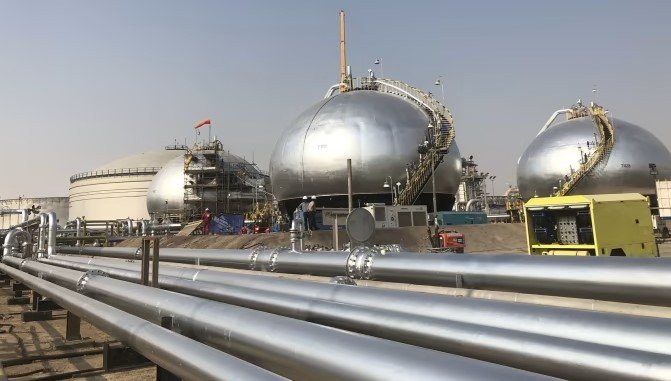Earnings dip to $24.5 billion amid falling crude prices and weaker refined product margins
Saudi Aramco has now clocked a full 10 quarters of falling profits, a streak that began back in early 2023. The oil giant’s Q2 2025 results, announced Tuesday, reveal another sharp drop in revenue—despite upbeat forecasts from the top brass.
The numbers weren’t catastrophic, but they sent another warning shot through global energy markets. Net income fell to $24.5 billion, down from $26 billion in Q1 and significantly below the highs of 2022. Revenues dropped to $101 billion, compared to $116 billion a year ago.
Crude Prices Take a Toll
Two years ago, Saudi Aramco was riding high on the back of a war-fueled price surge. Now, it’s wrestling with a very different picture.
Crude oil prices have softened in recent months, easing well below the $100-per-barrel highs that followed Russia’s invasion of Ukraine. Benchmark Brent prices hovered between $75–$80 during much of Q2. That’s decent—but not enough to keep Aramco’s juggernaut earnings rolling.
Even refined products, once a cushion for falling crude margins, are seeing thinner spreads.

“Lower crude oil prices and lower refined and chemical product prices were the main drivers behind the dip,” the company said in its quarterly filing.
One sentence says a lot.
Stock Slide, Valuation Hit
The company’s stock ended Tuesday’s session at 24.02 riyals ($6.40), falling nearly 12% below its 2024 secondary share offering price.
That secondary offering, which saw the Kingdom sell 0.64% of its Aramco holdings, raised $11.2 billion just last year. It was the largest such deal since the original 2019 IPO.
Meanwhile, Aramco’s market value—once a towering $2.4 trillion—is now closer to $1.6 trillion.
That’s a staggering drop. A third of its market capitalization has vanished in just three years.
And it’s not just about numbers:
-
Investors are rethinking Big Oil’s valuation in a world gradually shifting to renewables
-
Persistent global supply growth is weighing on prices
-
High costs and capital spending in newer energy initiatives are keeping margins tight
CEO Sticks to Long-Term Playbook
Despite the back-to-back quarters of pressure, CEO Amin Nasser was in no mood to sulk. His tone was strikingly confident.
“We anticipate oil demand in the second half of 2025 to be more than two million barrels per day higher than the first half,” Nasser said, citing solid fundamentals.
He stressed that hydrocarbons—despite the push for cleaner energy—will remain central to global energy security.
In one sharply worded sentence, he made Aramco’s position clear.
“We are ready to play our part in meeting customer demand over the short and the long-term.”
What that means is: the company isn’t backing away from oil. It’s doubling down.
Gas Ambitions and Jafurah Field
Still, Aramco’s not blind to change. One area getting more attention lately? Natural gas.
The company has laid out ambitious plans to grow its gas output by more than 60% by 2030 from 2021 levels. Much of that hinges on its Jafurah field—an enormous reserve southeast of Ghawar.
It’s one of the Kingdom’s most significant unconventional gas plays.
That push toward gas has two major goals:
-
Reduce domestic reliance on oil for electricity generation
-
Free up more crude for export, keeping revenues strong
One paragraph can’t cover it all. But natural gas is shaping up to be Aramco’s next big bet.
Dividends Still Flowing—For Now
Despite tighter earnings, Aramco is still dishing out hefty rewards to shareholders.
In Q2, it declared a $21.1 billion base dividend, plus a performance-linked bonus of $0.2 billion. That might not sound like much compared to prior years, but it’s enough to keep investors interested.
Here’s how it stacks up:
| Category | Q2 2025 Value | Q1 2025 Value |
|---|---|---|
| Net Income | $24.5 billion | $26 billion |
| Revenue | $101 billion | $107 billion |
| Base Dividend | $21.1 billion | $21.3 billion |
| Performance Dividend | $0.2 billion | $0.3 billion |
CFO Ziad Al-Murshed says internal belt-tightening is helping fund these payouts. “We’re not just cutting costs,” he said in the post-earnings call, “we’re transforming entire portfolios—upstream and downstream.”
It’s about efficiency and survival in a leaner price environment.
From IPO Glory to Strategic Shifts
Saudi Aramco’s 2019 IPO was historic. At $29.4 billion, it remains the world’s largest listing.
That deal saw just 1.7% of the company sold off, but it was symbolic. The Kingdom opened the door for private investors to buy into its crown jewel.
Since then, more has changed:
-
A 16% stake is now with the Saudi Public Investment Fund (PIF), a key pillar of Crown Prince Mohammed bin Salman’s Vision 2030
-
The PIF has been using energy wealth to back everything from sports to AI to futuristic cities
-
Aramco’s role is shifting from just oil producer to national growth enabler
That pressure to deliver beyond profits is growing.
A Cautious Second Half Outlook
Looking ahead, there’s cautious optimism, but also headwinds.
Demand is forecast to rise, especially from China and India. But global inventories remain high. And U.S. shale, ever the swing factor, is showing signs of life again.
OPEC+, too, is sending mixed signals. Cuts help—but only up to a point.
Then there’s the dollar, inflation, and potential interest rate shifts. All of it matters.
And here’s the thing: oil markets hate uncertainty.
So while Aramco’s management remains confident, analysts are a bit more wary. They’re watching refining margins, capital spending plans, and geopolitical risks—especially in the Middle East.
